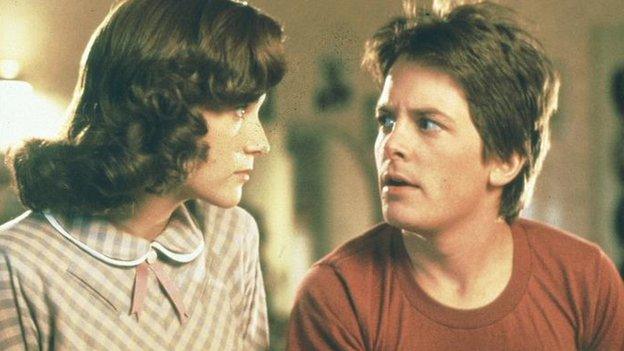Back to the Future: What does 2015 have in store?
- Published

For those of you who remember the Back to the Future movies, 2015 was the year to which Michael J. Fox travelled forward in time.
The movie predicted that we would be driving flying cars, using hoverboards… more on that later.
I was struck that this year, 2015, seems poised to repeat key aspects of the past.
Notably, there's talk of the renaissance of the US.
The combination of cheaper energy due to shale gas, rising overseas wages, and the long-standing innovative edge has led to a revival of manufacturing, particularly high-end, but also mid-skill industries, such as cars.
That feels like a throwback to a time when Made in America was dominant. That was what Michael J. Fox saw when he went back to the 1950s.
The eurozone also feels like it is going through a repeat of the worst of the crisis that seemed to have finally eased last year.
That's when terms like Grexit, i.e., Greece leaving the euro, were bandied about, and jittery markets led to sell-offs.
Greece's upcoming election on 25 January is causing nervousness.
Yields on Greek's bonds are at unaffordable highs again and there's talk of contagion as the euro plummets to nearly its lowest level since the formation of the single currency.

But, there are now more pan-euro institutions, such as the newly formed banking union, and notably the European Central Bank looks likely to open the taps and inject cash via quantitative easing.
Of course, the fate of the euro, as I've written about before, is more driven by politics than economics. You can read more about that in my colleague Robert Peston's blog.
Lead dragon?
For China, it seems to be on the same loop of concerns over its debt level and the possibility of a hard landing if it can't successfully restructure its economy away from unsustainable investment.
Economic growth rates are being revised down and even 7.5% won't look to be repeated in 2015.
Lower tax receipts could cause a fiscal squeeze, which won't be welcome as the government seeks to increase urbanisation and social welfare provision.
All the while, Chinese firms are racing ahead with double and even triple digit sales growth.
Indeed, the stock market had skyrocketed by 53% in 2014. This dichotomy was also seen in the mid 2000s when it the economy was roaring ahead with around 10% growth while the stock market lost half of its value.
There's a reason why the stock market was described then as a casino. Of course, the structure is somewhat different now, but the feeling that we've been here before remains.
Abe 2.0
For Japan, it is aiming for a revival, in a sense to go back to a time before the 1990s crash, when it was the innovative leader and the country that seemed poised to challenge the US for economic dominance.
Recall that it was the country that was mentioned by Michael J. Fox as producing technologically advanced products in the 1980s.
It is trying to do so again. On my recent trip, I met a robot and have experienced some of the impressive advances in artificial intelligence.
I have also, though, seen the challenges that face a country where corporate culture isn't nimble.
For what it is worth, my outlook for the year is that we are not quite repeating the past but there are echoes of it, which I was reminded of by the Back to the Future movies.
And I do wonder sometimes if politicians and policymakers wish that they could go back in time and change course.
So, coming full circle to the movies — their view of the future isn't too far off-piste. The emergence of hyper-competitive smartphone, social media and e-commerce companies, producing phones with artificial intelligence like Siri and drones that deliver parcels, will continue to push tech boundaries.
It may not be this year, but soon we may all have hoverboards; though probably not a time travelling DeLorean.